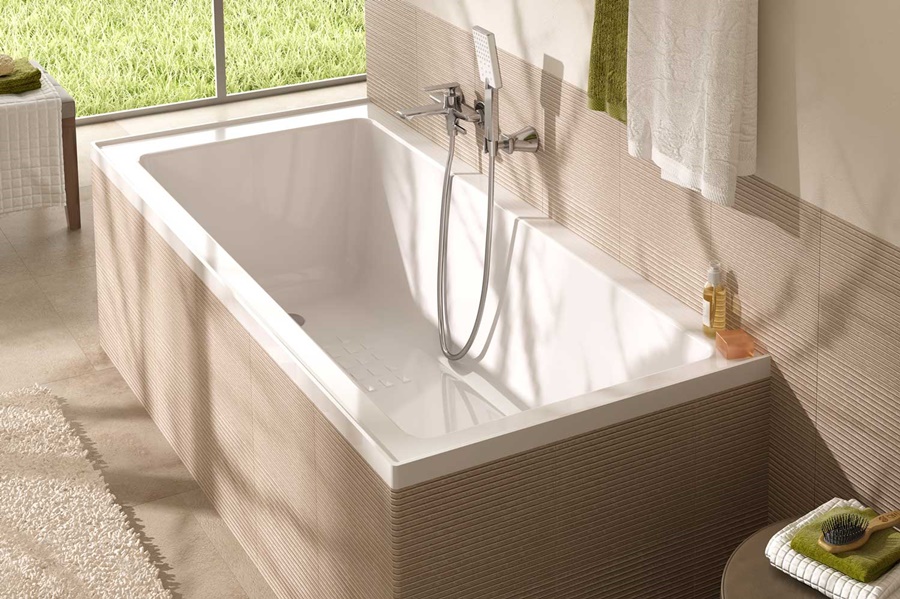When choosing a bathtub, knowing the exact dimensions is essential to ensure a perfect fit, both in terms of functionality and aesthetics. One of the most frequently asked questions by homeowners and renovators alike is: “How wide is a bathtub?” In this detailed guide, we’ll explore standard bathtub widths, various styles and their dimensions, and provide everything needed to make an informed decision.
Standard Bathtub Width: A Precise Breakdown
In the United States, standard bathtubs typically have a width ranging from 30 inches to 32 inches. This measurement refers to the interior dimension from one side wall to the other, and is commonly found in alcove bathtubs, which are installed between three walls.
Minimum standard width: 30 inches (76.2 cm)
Typical average width: 32 inches (81.28 cm)
Maximum for standard tubs: Up to 36 inches (91.44 cm)
These standard sizes accommodate most bathrooms, offering enough room for a comfortable soak while conserving valuable floor space.
Bathtub Width by Type: Complete Comparison
Understanding bathtub width requires examining the type of bathtub, as different designs vary significantly in dimensions. Below is a detailed comparison of bathtub widths by style:
1. Alcove Bathtubs
Alcove tubs are the most common and space-efficient choice for small to medium bathrooms.
Standard Width: 30 – 32 inches
Length: 60 inches (most common)
Depth: 14 – 20 inches
These are designed for built-in installation, with three surrounding walls and an open front for access.
2. Freestanding Bathtubs
Freestanding tubs are luxurious, statement pieces that demand more space.
Typical Width: 32 – 36 inches
Length: 55 – 72 inches
Depth: 15 – 24 inches
They offer more soaking room and aesthetic appeal, but require larger bathrooms due to their increased width and standalone nature.
3. Drop-In Bathtubs
These bathtubs are installed in a constructed deck and offer customizable shapes.
Width Range: 30 – 40 inches
Length: 60 – 72 inches
Drop-in tubs are wider and allow for deeper soaking. They are ideal for larger, modern bathrooms and custom builds.
4. Corner Bathtubs
Perfect for maximizing corner space in larger bathrooms.
Width (measured across front face): 48 – 72 inches
Depth: 18 – 22 inches
Though not traditional in shape, corner tubs can accommodate two bathers and typically have triangular or heart-shaped designs.
5. Walk-In Bathtubs
Specially designed for accessibility, walk-in tubs vary widely in size.
Width: 26 – 32 inches
Length: 52 – 60 inches
Depth: 35 inches or more
These tubs are compact yet tall, allowing easy entry with a door and seated bathing, often used in senior living or accessible homes.
Custom and Oversized Bathtubs: When Bigger Is Better
For homeowners designing luxury bathrooms, custom-sized bathtubs are often preferred. These can exceed 36 inches in width and offer double-ended or whirlpool options.
Extra Wide Widths: 40 – 48 inches
Jacuzzi Tubs Width: 32 – 48 inches
Garden Tub Widths: 36 – 48 inches
These options provide ample room for stretching out and are typically deeper, enhancing the bathing experience.
What Influences the Width of a Bathtub?
Several factors determine the appropriate bathtub width:
Bathroom Size: Measure your space carefully; widths beyond 32 inches may require extensive bathroom remodeling.
User Needs: Consider who will use the tub taller individuals or users with mobility challenges may need wider tubs.
Plumbing Configuration: Standard alcove tubs fit common plumbing setups; wider tubs might need custom water and drain placement.
Aesthetic Preference: Wider tubs often look more luxurious, fitting better with high-end interiors.
Choosing the Right Bathtub Width for Your Space
Before deciding on the width, perform the following checks:
1. Measure Bathroom Dimensions: Ensure there's at least 4–6 inches of clearance around the tub.
2. Consider Future Resale Value: Standard dimensions are more universally appealing.
3. Check Doorways and Hallways: Larger tubs might not fit through your home’s entry points during delivery.
4. Test the Fit: If possible, sit or lie in a showroom tub to assess personal comfort.
Common Bathtub Widths by Installation Type
| Bathtub Type | Width (inches) | Width (cm) |
|---|---|---|
| Alcove | 30 – 32 | 76 – 81 |
| Freestanding | 32 – 36 | 81 – 91 |
| Drop-In | 30 – 40 | 76 – 101 |
| Corner | 48 – 72 (diagonal) | 122 – 183 |
| Walk-In | 26 – 32 | 66 – 81 |
| Garden/Jacuzzi | 36 – 48 | 91 – 122 |
Bathtub Width and Comfort: What to Know
While length is often prioritized, width plays a crucial role in bath comfort. A narrow tub may limit arm movement or force bathers to sit upright. A tub at least 32 inches wide allows a more relaxed, reclining position, enhancing the overall experience.
For couples or shared baths, widths of at least 36 inches are recommended, especially in freestanding or corner tubs. These offer greater capacity without compromising space.
Tips for Measuring Your Space for a Bathtub
To ensure you select the right width:
Measure from wall to wall at the intended install location.
Account for tile or wall finish thickness.
Ensure at least 2 inches of clearance on each side of the tub for fitting and sealing.
Include access clearance for plumbing maintenance.
Conclusion
The width of a bathtub significantly impacts both comfort and installation feasibility. Whether you're outfitting a small guest bath or designing a spa-like retreat, there’s a perfect width to match your needs.
From standard 30-inch alcove tubs to luxurious 48-inch whirlpool models, today’s market offers countless choices to fit every lifestyle and design vision. Always consider space, plumbing, and user comfort when selecting your ideal tub width.

